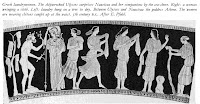The Dye Woorkes:Medieval & Renaissance Dye Recipes
Amazing website with fantastic classical dye recipes, information about mordants, books and manuscripts translated from German and French.
Quote from the website-
The use of the kermes insect (coccus ilicis L.) among the Greeks has been discussed in an earlier issue of this journal (cf. Ciba Review No. 7, “Scarlet”). Apart from the conchyliae, kermes was the only animal dye used by the Ancients. Kermes dye was expensive, but it was cheaper than purple, and therefore frequently used as a substitute for it. Dioscorides already expressed the opinion that kermes is not a plant, but an animal.
My friend Louise talked about this insect or grub, in her communion message at church last night, in Hebrew it’s Tola or Towla. When the female worm dies it releases a scarlet or crimson liquid which soaks the worm and the tree bark it is on. The dead female is harvested, dried and crushed for making a scarlet dye. I gather that the Israelites used this as well as the Greeks mentioned above. Here is a message along the same lines as Louise’s. The Gospel In A Bug
More quotes from the website-
A number of recipes are concerned with the solution of alcanna. It is dissolved in oil and water, but best of all with camel’s urine, which preserves the red colour better than any other agent.
91. The Fixation of Alkanet.
Urine of sheep, or arbute-berry, or henbane in the same manner.92. Falsification of Alkanet.
Alkanet is diluted with pine cones, the inside part of peaches, purpura, beet juice, dregs of wine, the urine of a camel and the interior of citrons.93. Fixation of Alkanet.
Navelwort and alum mixed in equal parts, crush finely (and) throw the alkanet in it.94. Styptic agents.
Melantheria, calcined copperas, alum, chalcitis, cinnabar, lime, bark of pomegranit, pod of a thorny tree, urine with aloes. These things serve in dying.

